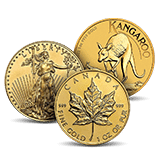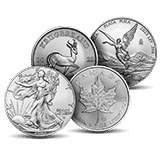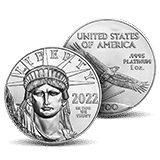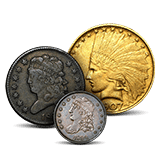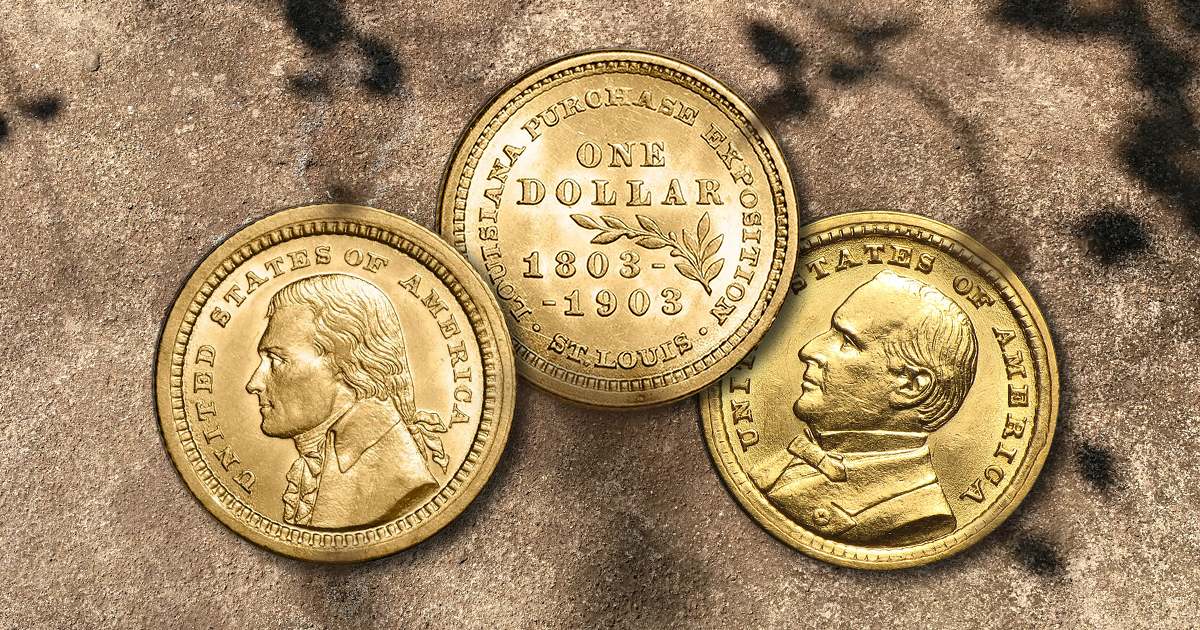
The Louisiana Purchase Exposition Dollar was issued in 1903 as the first gold commemorative coin struck by the U.S. Mint. It was struck to honor the centennial of the Louisiana Purchase and the 1904 St. Louis World’s Fair. The Louisiana Expo Dollar had two obverse varieties that shared a reverse design, with one obverse featuring President Thomas Jefferson and the other depicting President William McKinley. Between the two issues, the Louisiana Purchase Expo Dollar had a distribution of about 35,000 coins and a total mintage of 250,000.
Background and Purpose
The 1904 St. Louis World’s Fair, officially known as the Louisiana Purchase Exposition, marked the centennial of the 1803 Louisiana Purchase that doubled the size of the United States. Congress authorized commemorative gold coins in 1902 as part of the fair’s $5 million budget, intending for them to serve as souvenirs and a fundraising tool for the exposition. Although they did not receive a positive response when they were released, they are valued today for their numismatic value and historical significance.
Design of the Louisiana Expo Dollar
Jefferson Louisiana Exposition Dollar Obverse
The Jefferson issue of the 1903 Louisiana Expo Dollar depicted a portrait of President Thomas Jefferson facing left. Charles E. Barber modeled his design on the Indian Peace Medal crafted by John Reich. Jefferson was honored for his role in securing the Louisiana Purchase, which doubled the size of the United States of America at the time.
McKinley Louisiana Exposition Dollar Obverse
Barber’s McKinley obverse design for the 1903 Louisiana Purchase Exposition Gold Dollar was rooted in the sessions where the President had sat for him. It similarly depicted McKinley facing left, and portraits from both issues were surrounded by UNITED STATES OF AMERICA and a beaded border inside the rim.
Reverse of the Louisiana Purchase Expo Gold Dollar
The reverse design depicted an olive branch separating the dual dates “1803–1903,” and inscriptions for the exposition and denomination.
Production and Sales
Production
The Philadelphia Mint began striking the Louisiana Purchase Exposition dollars in December of 1902, although the 75,080 coins that were produced that month bore a 1903 date. In January 1903, another 175,178 Louisiana Expo dollars were struck, with the overage designated for testing. It is not known which gold Expo dollar was struck first, nor if are there differences between the 1902 and the 1903-produced coins.
Sales
The Louisiana Expo dollars were sold for $3 each and were distributed at the exposition, via mail order, and through creative efforts that included mounting on spoons and jewelry.
Mintage and Distribution
A total of 250,000 gold dollars were authorized for the exposition, split evenly between the Jefferson and McKinley types, with 125,000 of each design struck. About 17,500 of each type were sold and distributed, while the remaining 215,000 coins were returned to the Mint and melted years later in 1914.
| Issue Type | Mintage | Distributed | Melted |
| Jefferson Dollar | 125,000 | ~17,500 | ~107,500 |
| McKinley Dollar | 125,000 | ~17,500 | ~107,500 |
| Total | 250,000 | ~35,000 | ~215,000 |
Composition and Specifications
The Louisiana Purchase Exposition dollars were struck in 90% gold and 10% copper, with a gold content of 0.04837 ounces. The coins have a diameter of 15 mm, a weight of 1.672 grams, as well as a reeded edge, and were produced at the Philadelphia Mint without a mint mark.
| Attribute | Value |
| Denomination | $1.00 |
| Composition | 90% gold, 10% copper |
| Gold Content | 0.04837 troy oz |
| Diameter | 15 mm |
| Weight | 1.672 grams |
| Edge | Reeded |
| Mint | Philadelphia (no mark) |
| Price | $3 per coin |
Legacy and Market Impact
Although the coins were a commercial disappointment in their time, their rarity and historical significance have made them highly sought after by collectors in later decades. High-grade examples, especially those in Mint State grades like MS-66 and above, consistently command strong prices at auction, often exceeding several thousand dollars.
Although the coins were not a commercial success at the time, their rarity, artistry, and historical resonance have made them coveted treasures in American numismatics. Their legacy is enriched by the story of these official gold dollars, which reflect the era’s fascination with commemorative art and the enduring appeal of America’s great expansion. Today, these coins are prized for their connection to a pivotal moment in U.S. history and the spirit of national celebration that defined the early twentieth century.
Collectors and historians continue to study the Louisiana Purchase Exposition dollar for its design, context, and the lessons it offers about the challenges of commemorative coin programs. The limited number of surviving examples, especially in high grades, ensures their continued desirability and investment potential.

